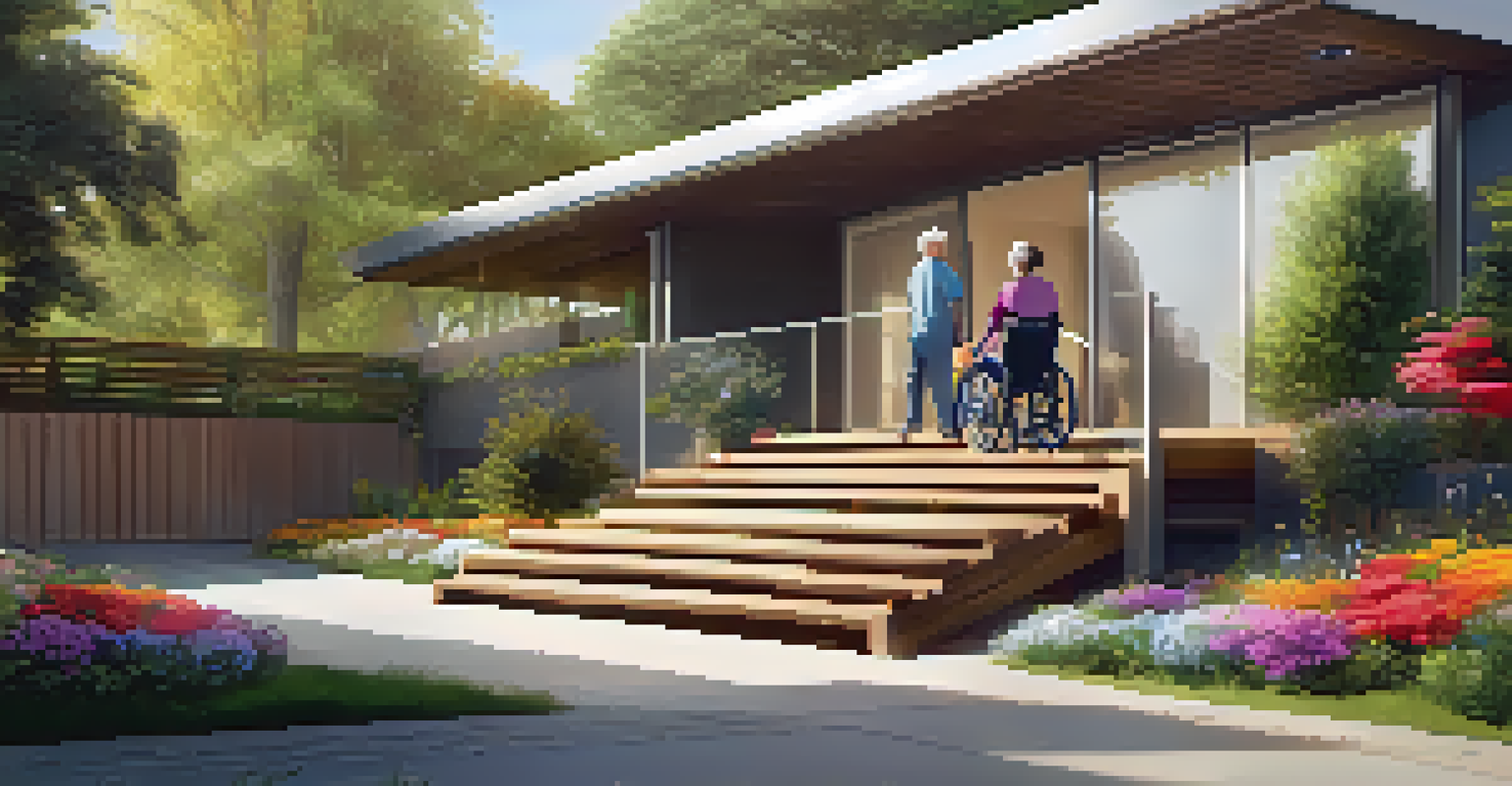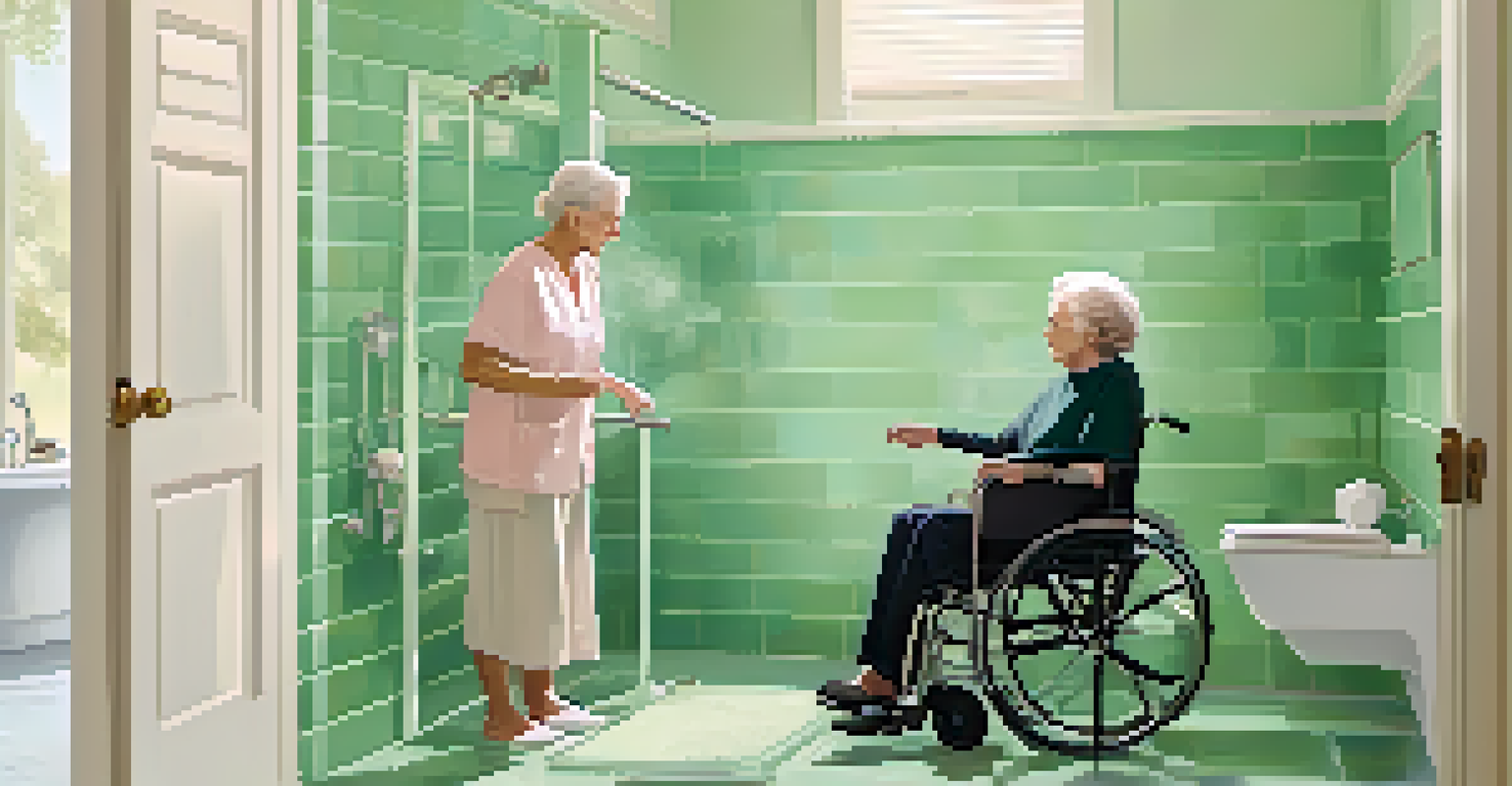The Benefits of Home Accessibility for Caregivers

Understanding Home Accessibility and Its Importance
Home accessibility refers to modifications made in a living space to improve ease of access for individuals with mobility challenges. These changes can range from installing ramps to adjusting cabinet heights. For caregivers, understanding this concept is crucial as it directly impacts their ability to provide effective support.
Accessibility allows us to live independently and with dignity, regardless of our physical challenges.
When homes are accessible, caregivers can navigate the space more easily, ensuring that their loved ones can move about safely and independently. This not only alleviates physical strain but also reduces stress for both parties. Ultimately, it creates a more harmonious living environment, which is beneficial for everyone involved.
Furthermore, home accessibility can foster a sense of dignity and autonomy in individuals with disabilities. By ensuring they can participate in daily activities, caregivers can empower their loved ones, enhancing their quality of life. This empowerment is a key component of successful caregiving.
Enhancing Safety for Everyone in the Home
One of the primary benefits of home accessibility is improved safety. Simple modifications, like installing grab bars in bathrooms or ensuring clear pathways, can significantly reduce the risk of falls and injuries. For caregivers, this means fewer emergency situations and less anxiety about their loved ones' well-being.

By creating a safer home environment, caregivers can focus more on providing emotional support rather than constantly worrying about physical hazards. For instance, a well-lit entrance with non-slip surfaces can make a world of difference, especially during inclement weather. This peace of mind is invaluable.
Home Accessibility Enhances Caregiving
Modifying homes for accessibility allows caregivers to provide better support and fosters independence for individuals with mobility challenges.
Moreover, when caregivers feel confident in the safety of their home, they can dedicate more time to meaningful interactions with their loved ones. This quality time can strengthen relationships and improve overall emotional health, making caregiving a more fulfilling experience.
Boosting Independence for Those with Mobility Challenges
Accessibility features empower individuals with mobility challenges to live more independently. For instance, a stairlift can allow someone to navigate between floors without assistance, fostering a sense of control over their environment. This independence is not just beneficial for the individual but also for the caregiver.
The greatest gift is not being afraid to question.
When caregivers see their loved ones thriving in an accessible environment, it often leads to a more positive caregiving dynamic. They can spend less time on physical assistance and more time engaging in enjoyable activities together. This shift can significantly enhance their relationship.
Additionally, promoting independence can alleviate caregiver burnout, a common issue in caregiving. By enabling loved ones to perform daily tasks on their own, caregivers can find moments to recharge, ensuring they remain healthy and present for their families.
Facilitating Better Communication and Interaction
Home accessibility goes beyond physical changes; it can also enhance communication and interaction. When spaces are designed with accessibility in mind, caregivers can create an environment that encourages dialogue and connection. For instance, an open floor plan allows for easier conversation during family gatherings.
Accessible homes can also accommodate adaptive technologies that aid communication, such as voice-activated devices. This technology can bridge gaps for individuals who might struggle with traditional methods, fostering a sense of inclusion. Caregivers can feel more connected to their loved ones, which enriches the caregiving experience.
Safety Improvements Reduce Anxiety
Simple modifications like grab bars and clear pathways significantly enhance safety, reducing the risk of injuries and alleviating caregiver stress.
Moreover, when caregivers and their loved ones can communicate effectively, it builds trust and understanding. This foundation is crucial for addressing any additional needs or concerns that may arise, ultimately leading to a more harmonious living situation.
Reducing Physical Strain on Caregivers
Caregiving can be physically demanding, especially if the home is not designed for accessibility. Modifications like widened doorways and adjustable furniture can help reduce the physical strain on caregivers. These changes allow for smoother transitions and easier access to necessary items.
By minimizing physical challenges, caregivers can focus on their loved ones’ emotional and psychological needs rather than just physical support. For example, having a shower chair in the bathroom can make bathing safer and easier for both the caregiver and the individual being cared for. This simple addition can save time and energy.
Ultimately, reducing physical strain is essential for the longevity of a caregiver's role. When caregivers are less fatigued, they can maintain a positive attitude and provide better care, leading to improved outcomes for their loved ones.
Improving Overall Quality of Life for Caregivers
Home accessibility not only benefits those with mobility challenges but also significantly enhances the quality of life for caregivers. When caregivers are not bogged down by logistical challenges, they can create a more enjoyable living environment. This can lead to more fulfilling experiences for everyone involved.
Accessible homes allow caregivers to engage in activities that bring joy and relaxation, such as cooking together or enjoying movie nights. These moments of connection are vital for emotional well-being, helping caregivers feel more satisfied in their roles. It turns caregiving from a daily chore into a rewarding experience.
Community Engagement Boosts Well-Being
Accessible homes encourage social interaction, helping caregivers build support networks that enrich their lives and those they care for.
Additionally, improving quality of life can lead to better mental health for both caregivers and those they care for. A supportive and accessible home fosters resilience, enabling families to face challenges together. This positive mindset can transform the caregiving journey into one filled with love and shared growth.
Encouraging Community and Social Engagement
Accessible homes often serve as a hub for social interaction, encouraging community engagement. When a home is welcoming and accommodating, caregivers can invite friends and family over without worrying about accessibility issues. This inclusion fosters a sense of belonging for everyone involved.
Moreover, social interactions can provide essential support for caregivers, helping to alleviate feelings of isolation. Sharing experiences with others who understand their situation can be incredibly beneficial. For example, support groups or friendly gatherings can offer respite from the challenges of caregiving.

By enhancing community ties, caregivers can create a network of support that enriches their lives and the lives of their loved ones. This sense of community can be a powerful motivator, reminding caregivers that they are not alone in their journey.
The Long-Term Benefits of Investing in Accessibility
Investing in home accessibility is not just about immediate needs; it also has long-term benefits for both caregivers and their loved ones. By making thoughtful modifications, families can ensure that their homes remain livable and supportive as needs change over time. This proactive approach can save time and money in the long run.
For instance, a home that accommodates aging in place allows individuals to stay in a familiar environment, which can be comforting during challenging transitions. This stability can significantly reduce stress for both caregivers and those they care for. It shows that accessibility is not just a one-time fix but an ongoing commitment to quality of life.
Ultimately, the benefits of home accessibility extend beyond physical structures; they create a nurturing environment that promotes health, happiness, and well-being. For caregivers, this means a more manageable role that fosters growth and connection, leading to a fulfilling journey together.